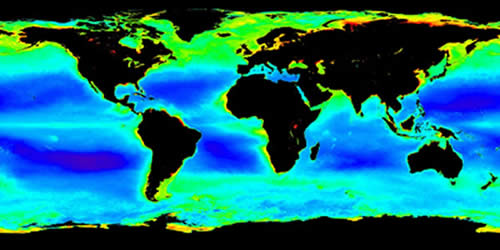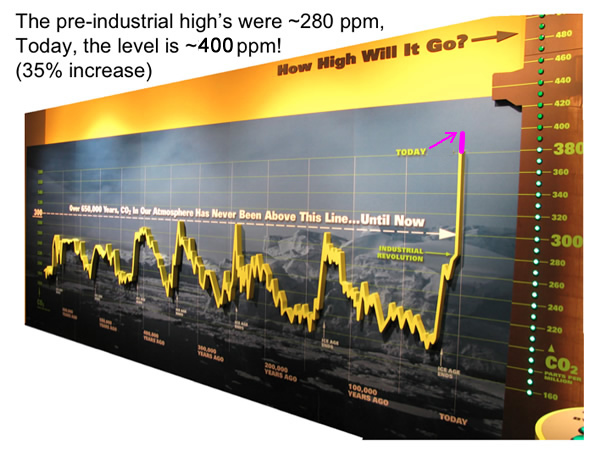Climate change -- a geologic perspective.
3. Changes in the Earth's orbit -- causes changes in the amount of energy absorbed by the surface of the Earth.
Interrelationships: Global climate is complex -- there are many feedback mechanisms (both positive and negative) and some parameters amplify others (eg. Greenhouse gases can increase after warming is initiated by changes in the Earth's orbit and amplify the resulting global warming).
Surface water productivity as shown by chlorophyll concentration (red colors represent high concentrations and blue represents low ones) in the surface ocean. Measured by the SeaWIFS, photo from NASA's Web site.
Global Climate is getting warmer:
The map of the world on the right shows the temperature anomalies (red colors are warmer, blue ones are colder) over the last 10 years relative to the 30-year period 1951-1980. From NASA: http://earthobservatory.nasa.gov/IOTD/view.php?id=47628&src=eoa-iotd (accessed Dec. 14, 2010.
See this link to compare temperature anomalies by decade since 1880.
See this video for a good summary of what has been known about climate change over the last 30+ years.
See this article for a meterologist 's view of extreme weather and climate change.
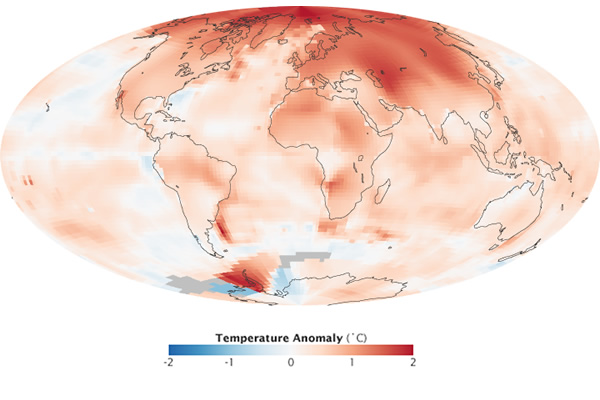
What we know:
- The Earth is getting warmer.
- The lower atmosphere (troposphere) is getting warmer (the upper atmosphere has been actually getting cooler-- exactly what is predicted to happen if warming is due to green house gases and not changes in the sun).
- The oceans are warming.
- The greenhouse effect is scientifically well understood -- and has been known for about 150 years.
- Greenhouse gas (methane, carbon dioxide, CFC's, ozone, etc) concentrations are increasing rapidly*.
- Greenhouse gas concentration changes coincide with global climate change in the past.
- It will take at least 1000 years for the carbon dioxide we have put into the atmosphere by burning fossil fuels to be be absorbed by the oceans and terrestrial vegetation.
- Over millions of years, the global climate has been much warmer and cooler than today.
- Plants can take up carbon dioxide, but a recent study has shown that increased plant growth will only have a small effect in slowing global warming.
The graph above is from a display at the Birch Aquarium at Scripps Oceanographic Institution in San Diego. It shows the concentration of carbon dioxide in the Earth's atmosphere over the last 500,000 years. Here is a link to a nice video from the Birch Aquarium that deals with global warming.
Can Sunspot Activity Explain Global Warming?
"I absolutely do not believe in the science of man-caused climate change,"
"It's not proven by any stretch of the imagination."
"It's far more likely that it's just sunspot activity or just something in the geologic eons of time,"
Ron Johnson, August 2010 (from http://www.jsonline.com/news/statepolitics/100814454.html accessed December 10, 2010)
People are entitled to their own beliefs, but not their own facts. Sunspots are dark areas that represent zones marked by intense magnet fields on the sun's surface and are often accompanied with faculae, which are very bright areas. Both are more abundant during times of increased solar activity, but the effect on global climate, although likely small, is not straight forward. Solar activity has varied over time, and some variations in the past have occurred with times of climate change, but sunspot activity has decreased over the last 30 years -- while global temperature has been increasing:
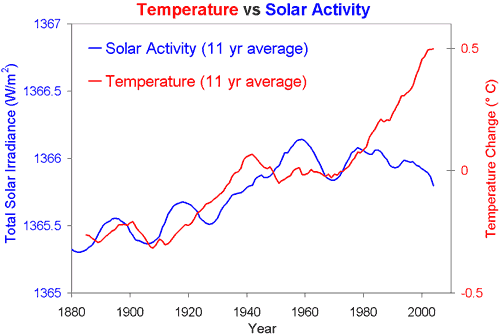 |
From http://www.skepticalscience.com/solar-activity-sunspots-global-warming.htm (accessed Dec. 10, 2010). |
Here is a great video that discusses the relationship of sunspots to global climate change.
Here is the bottom line regarding sunspots and global climate change from the Skeptical Science web page (accessed Dec. 2, 2010).
"...neither direct nor indirect solar influences can explain a significant amount of the global warming over the past century, and certainly not over the past 30 years. As Ray Pierrehumbert said about solar warming,
“That’s a coffin with so many nails in it already that the hard part is finding a place to hammer in a new one.”"
This NASA web site provides in-depth explanation of sunspots, sunspot activity cycles, and predictions into the future.
Press sources often try to be "fair and balanced" -- but end up giving equal time to unsupported, wild competing ideas. Here is a 2004 story aired by the British Broadcasting News service that presents a contradictory view of sunspot influences on global climate. It first suggests that sunspot activity may be causing global climate change, but then at the end of the article the author states that sunspot activity does not correlate to global temperature rise in the last 20 years. "Over the past 20 years, however, the number of sunspots has remained roughly constant, yet the average temperature of the Earth has continued to increase."
Here is another good web site to check out sunspots and their effect on climate; here is another assessment of solar cycles and climate change, and here is another.
Here is an article that discusses the fact that the lower atmosphere (troposphere) is warming while the upper atmosphere (stratosphere) is cooling, which suggests that greenhouse warming, and not sunspot activity, is causing global warming.
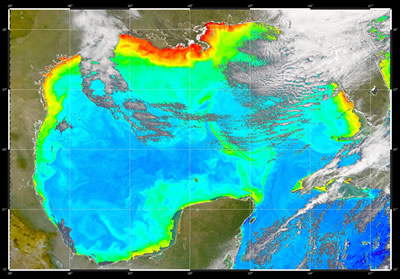
Productivity in the Gulf of Mexico as shown by the chlorophyll concentration (red colors represent high concentrations and blue represents low ones) in the surface water. Photo from NASA's SeaWIFS satellite page,
News organizations are often involved in trying confuse (mislead) people about climate science. Here is another example.
Greenhouse gas rise today is about 30 times greater than during ancient intervals of global warming.
